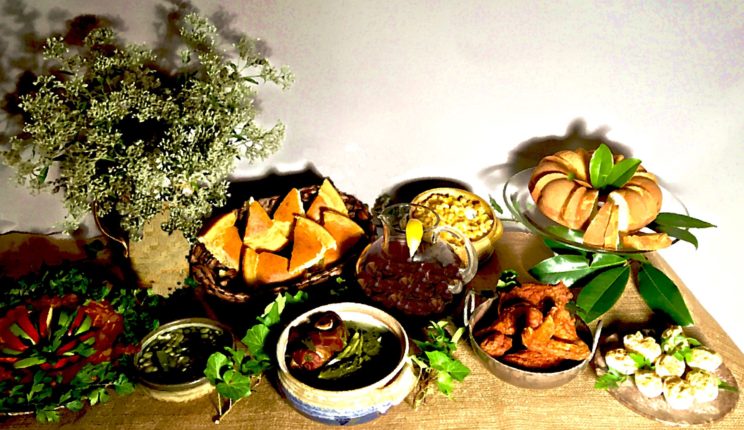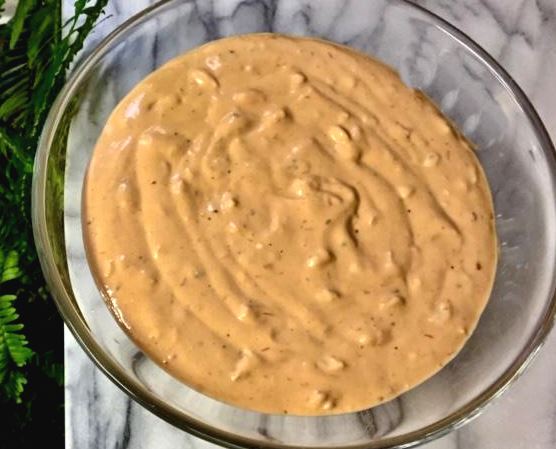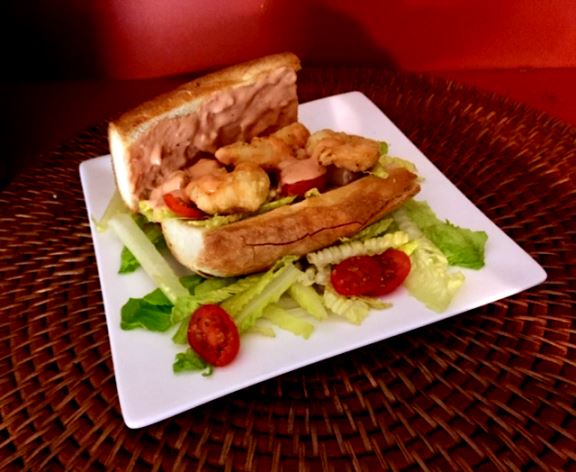The Southern Spread

by deborah fagan carpenter
Our culture, our history, our spirit, and our hospitality are some of the ingredients. Southern foods are heavily influenced by African, English, Scottish, Irish, French, and Native-American cuisine, and although most of them are served across the country today, there are foods in the U.S. that are strictly thought of as SOUTHERN. There’s Creole, Lowcountry and Floribbean, and I’m not sure where fried chicken and deviled eggs fit into the mix, but to be certain, they perform with a southern accent. In “The Southern Spread,” we’re exploring southern foods and traditions.
This Month’s Feature:
Comeback Sauce
In 1936 Alex Dennery created a house salad dressing at his Rotisserie restaurant in Jackson, Mississippi that was so delicious it kept his patrons coming back for more; thus the eventual name — Comeback Sauce. The Greek restaurateur charged his cooking staff with developing a unique sauce that could become their signature dressing, but, when none of their concoctions lived up to his expectations, he crafted his own.
Born in Greece as John Alexander Tounaris, Alex Dennery shared standing with other Greek immigrants who had a significant impact on the Jackson, Mississippi restaurant scene. One of the original Greek restaurants in the city, the Mayflower Café, is still serving its version of Comeback Sauce, as do other notable Jackson eateries, including Walker’s Drive-In. But, although the Mayflower is often credited with inventing Comeback Sauce, food historians and “Comebackologists” make it clear that the Rotisserie is the restaurant at which the sauce originated.

(Legend has it that the Rotisserie shares a place in literary history as well as its position in the culinary world. The now long-retired restaurant was originally a drive-in theater, located at Highway 49 and Five Points, a spot where five streets converge. Because of its unique location at the five-point junction, when he remodeled it, Dennery gave the restaurant five different entrances. In an effort to creatively entertain Henry Miller, a rather frequent visitor to her home in Jackson, Eudora Welty took her fellow-writer to the Rotisserie on five occasions by way of a different door each time. Perhaps “over-served” during some, if not all of the evenings that they dined out, Miller was rather impressed with the number of excellent restaurants to be found in Jackson, Mississippi.)
Comeback Sauce seems to be a close relative of Louisiana Remoulade Sauce and Thousand Island dressing. It’s not clear whether or not Alex Dennery knew of or was influenced by either, but the three share distinct similarities. It could be that the combination of some of the ingredients for all of them just make logical sense in culinary science. However, hard-boiled eggs, pickle relish, pimento, or olives might be included in Thousand Island, and Remoulade often employs green onions, celery, parsley, and capers — none of which are found in most Comeback Sauce recipes.
The original Rotisserie Comeback Sauce recipe is a well-guarded secret, but it’s believed that Dennery began his creation with homemade mayonnaise, chili sauce, and garlic. Other ingredients that he probably added and which are usually included in the sauce today are grated or finely chopped onion, lemon juice, Worcestershire Sauce, and paprika. Some quantity of all of these are in most versions, and it’s speculate that the Mayflower’s contains some form of celery— possibly celery seed.

Whatever minor adaptations there are to the legendary sauce which today is served all over the South and elsewhere, its versatility is endless. Its purpose has been elevated from serving as a mere salad dressing to being used as a dip for everything from fried dill pickles to French fries, fried mushrooms, onion rings, and raw vegetables. It’s often served on chicken sandwiches, seafood sandwiches, fried green tomatoes, soft shell crabs, and even hamburgers. And, in the absence of anything else, it’s pretty good on a plain ole Saltine cracker.
Below is a recipe that’s believed to be close to the original:
Ingredients:
1 tbsp. water
2/3 cup chili sauce
1/2 cup vegetable oil
1 lemon, juiced
1 tsp Worcestershire sauce
1 dash Louisiana hot sauce
1 tsp black pepper
1 small onion
1 cup mayonnaise
1/4 cup ketchup
1 tsp dry mustard
1 dash paprika
1 tsp salt
3 cloves garlic
Directions:
Assemble all ingredients. Juice lemon and discard rind. Process in blender or food processor until smooth. Store in the refrigerator. If using fresh garlic, use within two days.
Photo Images: Deborah Fagan Carpenter



Fascinating story! I am always interested in unique recipes developed in more recent history that have become ubiquitous in our culture. Reminds me of Weidemann’s bourbon pie!
An all-purpose sauce!